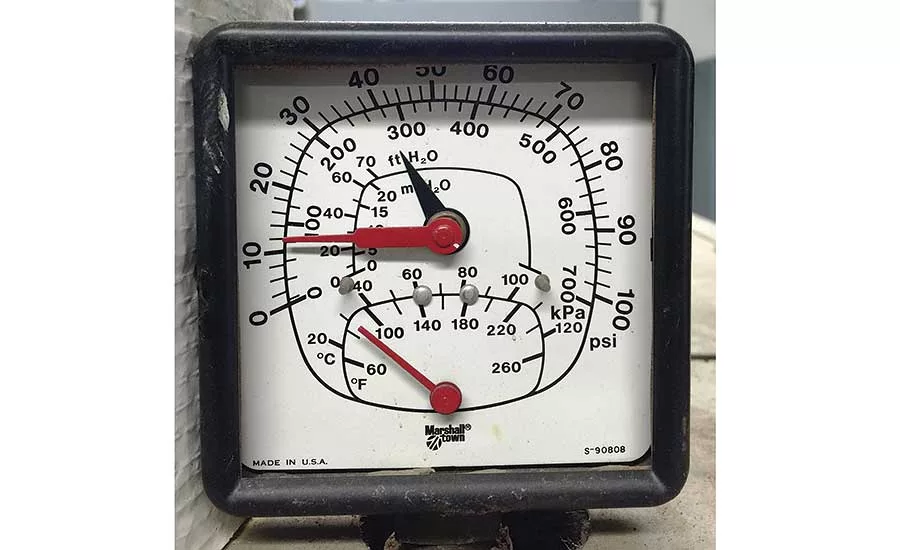Ray Wohlfarth: A dangerous situation

A tridicator like this reads boiler system pressure. Photo credit: Ray Wohlfarth
I sat on the wooden chair in the basement, closed my eyes, and took a deep breath. My hand was shaking and my heart racing. It is rare to have a service call scare me, as I have been doing boiler service for almost four decades.
But this one did scare me.
The day started with having more service calls than available technicians — a common occurrence on the first cold snap of the season. This was call No. 1 of three I planned for myself that day. I figured to be there no more than an hour or so, as we had seen this boiler each year for the last five and never had an issue.
Our previous visit was 11 months prior. The boiler was a small 15-year-old cast iron hydronic boiler with an intermittent pilot. The customer informed me when she phoned that the upstairs radiators were not heating and her “furnace” had a weird smell. I had already diagnosed and repaired the problems in my mind on the trip to the house. I figured the top radiators were air-bound and the smell was the odor of dust burning, common on the first heating cycles of the season.
As I had done so probably thousands of times in my career, I knelt down and placed a jumper on the thermostat terminals on the boiler, simulating a call for heat. While waiting for the water to heat, I removed the covers from the controls and tightened the wiring connections.
While I was replacing the control covers, my olfactory sense triggered an alarm in my brain and I looked up to see the boiler temperature gauge pegged at 260° F.
I jumped up and flipped the boiler’s electric switch to off.
“That’s the smell,” I heard the homeowner say from the kitchen above. Thanking her, I looked at the tridicator again and the system pressure read zero. The boiler had no water and no low-water cutoff.
My next thought was the pressure-reducing valve, which automatically feeds water to the system. I closed the manual upstream valve fearing the cold water would feed into the hot boiler, causing damage or an explosion. Luckily, the water feeder did not work. After allowing the boiler to cool for a while, I connected a hose to the boiler from the water heater and fed hot water to the boiler rather than cold.
Once the system pressure was up and the air was manually vented from the radiators, I applied the electrical jumper once again to start the burner, simulating a call for heat. I looked at the pump and saw it was not operating. The operating temperature control was adjusted to the lowest setting, and once the boiler water temperature reached 20° above the set point, I shut off the boiler, mentally condemning the control.
I met with the homeowner and showed her the price for the pressure-regulating valve, circulator and temperature operating control and also suggested the installation of a low-water cutoff. She was not happy.
“How could all these items go bad in one year?” she asked.
I shrugged my shoulders as I had no idea. I was the one who checked it last year and told her they worked properly at that time. My speculation as to the cause was the water somehow drained from the boiler and operating the pump and temperature control without water could have destroyed the components.
There was no sign of a leak in the boiler. Once the customer recovered from the sticker shock, she gave me the approval to replace the defective parts. The one-hour service call turned into a whole day event.
The lesson I learned from this service call is to always “be” at every service call. It sounds like some metaphysical saying someone like Aristotle or Plato would say. I was mentally at the next service call, and it almost cost my customer and me.
Look at each call like it is your first visit there. I have a checklist I use for doing my boiler service calls, as my mind tends to wander when doing menial tasks. I moved the part of checking the system pressure on my checklist to the first thing I look at on every call now. I swore to never take another heating system for granted.
How much pressure?
How much pressure do we need for a hydronic heating system? The system static pressure in the boiler is what lifts the water to the furthest ends of the building. When you look at the boiler pressure gauge, each pound of pressure will raise water 2.3 feet. Most residential hydronic systems use 12 psig at the standard setting for a two-story house with radiators on the second floor and the boiler in the basement.
To calculate how much pressure you will need, divide the height of the highest radiator by 2.3 feet. That will be enough pressure to just reach the top radiators. You then add 4 pounds extra as a safety factor. To see how much pressure we need for a three-story building with the baseboard radiation 30 feet above the boiler, our calculation would be this:
(30 feet ÷ 2.3) + 4 = 13.04 + 4 = 17.04, or 17 pounds.
In case you were wondering as to what happened to all the water in the boiler, the owner had connected a hose to the boiler to clean the garage floor. When he removed the hose, the valve dripped. They thought it would stop, and it eventually did — when the boiler ran out of water.
Looking for a reprint of this article?
From high-res PDFs to custom plaques, order your copy today!






